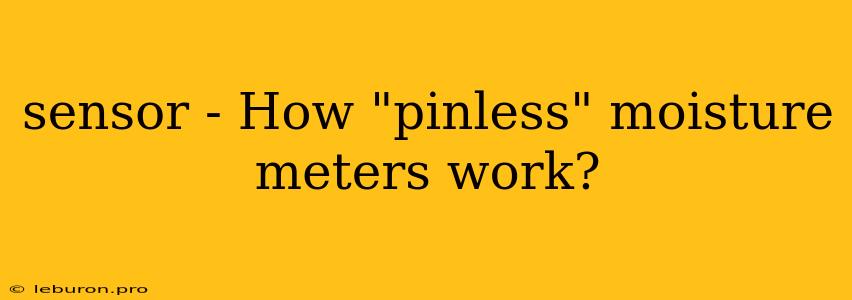Moisture meters are essential tools for professionals and homeowners alike, offering a convenient and precise way to measure the moisture content of various materials. While traditional moisture meters rely on pin electrodes to penetrate the material, a newer technology has emerged: pinless moisture meters. These devices utilize a different approach, offering several advantages over their pin-based counterparts. This article delves into the workings of pinless moisture meters, exploring their principles of operation, benefits, and applications.
Understanding the Fundamentals of Pinless Moisture Meters
Pinless moisture meters, as the name suggests, operate without the need for invasive pins. Instead, they employ electromagnetic waves to assess the moisture content of materials. This non-destructive approach makes them ideal for use on delicate surfaces or materials that cannot be punctured, such as finished wood, drywall, and concrete.
How Pinless Moisture Meters Work
The core principle behind pinless moisture meters lies in the interaction between electromagnetic waves and water molecules. Water, being a polar molecule, absorbs and reflects electromagnetic waves differently than dry materials. This difference in interaction provides the basis for moisture detection.
Here's a breakdown of the process:
- Electromagnetic Wave Emission: The meter emits electromagnetic waves, typically in the radio frequency range.
- Wave Interaction with Material: These waves penetrate the material's surface and interact with the water molecules present.
- Signal Analysis: The meter analyzes the reflected or absorbed waves. The amount of wave absorption or reflection is directly correlated with the moisture content.
- Moisture Reading Display: Based on the signal analysis, the meter displays the moisture content as a numerical value or a graphical representation.
Different Types of Pinless Moisture Meters
Pinless moisture meters can be broadly categorized into two main types:
-
Capacitance Meters: These meters operate by measuring the capacitance of the material. The capacitance, which is the ability to store electrical charge, changes based on the moisture content. Higher moisture content leads to increased capacitance, resulting in a higher reading on the meter.
-
Electromagnetic Field Meters: These meters work by analyzing the electromagnetic field that is created when waves interact with the material. The strength of the electromagnetic field is influenced by the moisture content. Higher moisture content leads to a weaker field, and the meter reflects this change in its reading.
Advantages of Pinless Moisture Meters
Pinless moisture meters offer several advantages over their pin-based counterparts:
- Non-Destructive: One of the most significant benefits of pinless meters is their non-invasive nature. They do not require puncturing the material, making them ideal for use on delicate surfaces, finished materials, and sensitive structures.
- Versatility: Pinless meters can be used on a wide range of materials, including wood, drywall, concrete, and even stucco.
- Faster Measurement: The absence of pins allows for quicker measurements as the meter does not need to physically penetrate the material.
- Surface Accuracy: Pinless meters provide accurate readings for the surface layer of the material, which is crucial for assessing the moisture level near the surface.
- Greater User Convenience: Their ease of use makes them suitable for both professionals and DIY enthusiasts.
Applications of Pinless Moisture Meters
Pinless moisture meters find application in various fields, including:
- Construction: Moisture meters are essential for monitoring moisture levels in building materials like wood, drywall, and concrete. They help identify potential moisture issues, prevent mold growth, and ensure the structural integrity of buildings.
- Restoration: Pinless moisture meters are invaluable tools for assessing water damage and guiding restoration efforts. They help determine the extent of moisture penetration and guide drying procedures.
- Home Inspection: Pinless moisture meters are widely used by home inspectors to assess the moisture content of various surfaces and identify potential problems related to water intrusion and leaks.
- Agriculture: Moisture meters are essential for monitoring soil moisture content in agricultural settings. This information helps optimize irrigation and maximize crop yields.
- Manufacturing: Pinless moisture meters are used in industries like wood processing, paper manufacturing, and food production to ensure the quality and consistency of materials.
Choosing the Right Pinless Moisture Meter
Selecting the appropriate pinless moisture meter depends on the specific application and the materials being tested. Factors to consider include:
- Type of Meter: Choose between capacitance or electromagnetic field meters based on the materials you're working with and the accuracy required.
- Measurement Range: Select a meter with a measurement range that covers the expected moisture content.
- Accuracy: The accuracy of the meter is crucial for reliable readings. Consider meters with high accuracy ratings, especially for critical applications.
- Features: Additional features like data logging, backlighting, and automatic calibration can enhance the user experience.
Conclusion
Pinless moisture meters have revolutionized moisture measurement by offering a non-destructive and versatile approach. Their ability to assess moisture levels without the need for invasive pins makes them invaluable tools for professionals and homeowners alike. By understanding how pinless moisture meters work, their advantages, and their applications, you can make informed decisions regarding their use and contribute to accurate moisture assessments in various settings.
